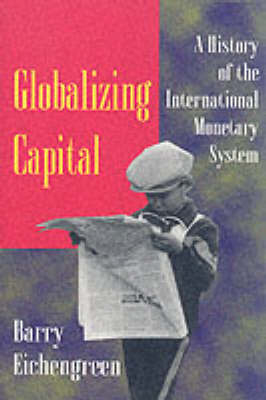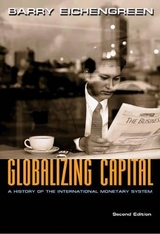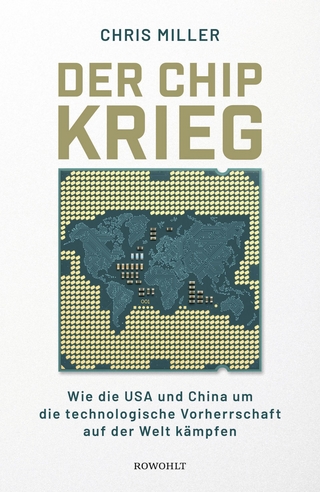
Globalizing Capital
A History of the International Monetary System - New and Updated Edition
Seiten
1998
|
Revised edition
Princeton University Press (Verlag)
978-0-691-00245-3 (ISBN)
Princeton University Press (Verlag)
978-0-691-00245-3 (ISBN)
- Titel erscheint in neuer Auflage
- Artikel merken
Zu diesem Artikel existiert eine Nachauflage
This volume tells the story of the international financial system over the past 150 years. It demonstrates that insights into the international monetary system and effective principles for governing it can result only if is seen as a historical phenomenon.
The importance of the international monetary system is clearly evident in daily news stories about fluctuating currencies and in dramatic events such as the recent reversals in the Mexican economy. It has become increasingly apparent that one cannot understand the international economy without knowing how its monetary system operates. Now Barry Eichengreen presents a brief, lucid book that tells the story of the international financial system over the past 150 years. Globalizing Capital is intended not only for economists but also for a general audience of historians, political scientists, professionals in government and business, and anyone with a broad interest in international economic and political relations. Eichengreen's work demonstrates that insights into the international monetary system and effective principles for governing it can result only if it is seen a historical phenomenon extending from the gold standard period to interwar instability, then to Bretton Woods, and finally to the post-1973 period of fluctuating currencies.
Eichengreen analyzes the shift from pegged to floating exchange rates in the 1970s and ascribes that change to the growing capital mobility that has made pegged rates difficult to maintain. However, he shows that capital mobility was also high prior to World War I, yet this did not prevent the maintenance of fixed exchange rates. What was critical for the successful maintenance of fixed exchange rates during that period was the fact that governments were relatively insulated from democratic politics and thus from pressure to trade off exchange rate stability for other goals, such as the reduction of unemployment. Today pegging exchange rates would require very radical reforms of a sort that governments are understandably reluctant to embrace. The implication seems undeniable: floating rates are here to stay.
The importance of the international monetary system is clearly evident in daily news stories about fluctuating currencies and in dramatic events such as the recent reversals in the Mexican economy. It has become increasingly apparent that one cannot understand the international economy without knowing how its monetary system operates. Now Barry Eichengreen presents a brief, lucid book that tells the story of the international financial system over the past 150 years. Globalizing Capital is intended not only for economists but also for a general audience of historians, political scientists, professionals in government and business, and anyone with a broad interest in international economic and political relations. Eichengreen's work demonstrates that insights into the international monetary system and effective principles for governing it can result only if it is seen a historical phenomenon extending from the gold standard period to interwar instability, then to Bretton Woods, and finally to the post-1973 period of fluctuating currencies.
Eichengreen analyzes the shift from pegged to floating exchange rates in the 1970s and ascribes that change to the growing capital mobility that has made pegged rates difficult to maintain. However, he shows that capital mobility was also high prior to World War I, yet this did not prevent the maintenance of fixed exchange rates. What was critical for the successful maintenance of fixed exchange rates during that period was the fact that governments were relatively insulated from democratic politics and thus from pressure to trade off exchange rate stability for other goals, such as the reduction of unemployment. Today pegging exchange rates would require very radical reforms of a sort that governments are understandably reluctant to embrace. The implication seems undeniable: floating rates are here to stay.
Barry Eichengreen is the John L. Simpson Professor of Economics and Political Science at the University of California, Berkeley. He is the author of European Monetary Unification: Theory, Practice and Analysis.
| Preface | |||||||||||||||||||||||||
| Ch. 2 | The Gold Standard | ||||||||||||||||||||||||
| Prehistory | |||||||||||||||||||||||||
| The Dilemmas of Bimetallism | |||||||||||||||||||||||||
| The Lure of Bimetallism | |||||||||||||||||||||||||
| The Advent of the Gold Standard | |||||||||||||||||||||||||
| Shades of Gold | |||||||||||||||||||||||||
| How the Gold Standard Worked | |||||||||||||||||||||||||
| The Gold Standard as a Historically Specific Institution | |||||||||||||||||||||||||
| International Solidarity | |||||||||||||||||||||||||
| The Gold Standard and the Lender of Last Resort | |||||||||||||||||||||||||
| Instability at the Periphery | |||||||||||||||||||||||||
| The Stability of the System | |||||||||||||||||||||||||
| Ch. 3 | Interwar Instability | ||||||||||||||||||||||||
| Chronology | |||||||||||||||||||||||||
| Experience with Floating: The Controversial Case of the Franc | |||||||||||||||||||||||||
| Reconstructing the Gold Standard | |||||||||||||||||||||||||
| The New Gold Standard | |||||||||||||||||||||||||
| Problems of the New Gold Standard | |||||||||||||||||||||||||
| The Pattern of International Payments | |||||||||||||||||||||||||
| Responses to the Great Depression | |||||||||||||||||||||||||
| Banking Crises and Their Management | |||||||||||||||||||||||||
| Disintegration of the Gold Standard | |||||||||||||||||||||||||
| Sterling's Crisis | |||||||||||||||||||||||||
| The Dollar Follows | |||||||||||||||||||||||||
| Managed Floating | |||||||||||||||||||||||||
| Conclusions | |||||||||||||||||||||||||
| Ch. 4 | The Bretton Woods System | ||||||||||||||||||||||||
| Wartime Planning and Its Consequences | |||||||||||||||||||||||||
| The Sterling Crisis and the Realignment of European Currencies | |||||||||||||||||||||||||
| The European Payments Union | |||||||||||||||||||||||||
| Payments Problems and Selective Controls | |||||||||||||||||||||||||
| Convertibility: Problems and Progress | |||||||||||||||||||||||||
| Special Drawing Rights | |||||||||||||||||||||||||
| Declining Controls and Rising Rigidity | |||||||||||||||||||||||||
| The Battle for Sterling | |||||||||||||||||||||||||
| The Crisis of the Dollar | |||||||||||||||||||||||||
| Ch. 5 | From Floating to Monetary Unification | ||||||||||||||||||||||||
| Floating Exchange Rates in the 1970s | |||||||||||||||||||||||||
| Floating Exchange Rates in the 1980s | |||||||||||||||||||||||||
| The Snake | |||||||||||||||||||||||||
| The European Monetary System | |||||||||||||||||||||||||
| Renewed Impetus for Integration | |||||||||||||||||||||||||
| The EMS Crisis | |||||||||||||||||||||||||
| Understanding the Crisis | |||||||||||||||||||||||||
| The Experience of Developing Countries | |||||||||||||||||||||||||
| The Asian Crisis | |||||||||||||||||||||||||
| Conclusions | |||||||||||||||||||||||||
| Ch. 6 | Conclusion | ||||||||||||||||||||||||
| Glossary | |||||||||||||||||||||||||
| References | |||||||||||||||||||||||||
Index
Mehr entdecken
aus dem Bereich die Ukraine, Polen und der Irrweg in der russischen Geschichte
Buch | Hardcover (2023)
C.H.Beck (Verlag)
28,00 €
wie die USA und China um die technologische Vorherrschaft auf der …
Buch | Hardcover (2023)
Rowohlt (Verlag)
30,00 €
| |||||||||||||||||||||||||



